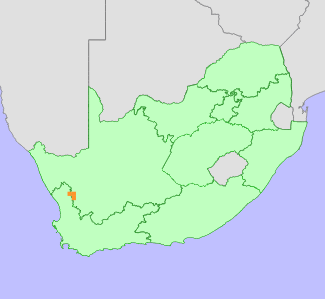|
Scientific Name | Leucadendron remotum I.Williams |
Higher Classification | Dicotyledons |
Family | PROTEACEAE |
Common Names | Nieuwoudtville Conebush (e) |
National Status |
Status and Criteria | Endangered A2abc; B1ab(ii,iii,v)+2ab(ii,iii,v) |
Assessment Date | 2020/07/20 |
Assessor(s) | A.G. Rebelo, D. Raimondo & N.A. Helme |
Justification | Leucadendron remotum is a restricted species with an extent of occurrence (EOO) of 258 km² and an area of occupancy (AOO) of 140-144 km². There has been an estimated 60 -70% population decline as a result of ongoing conversion of its habitat for the cultivation of rooibos tea. Remaining subpopulations are severely fragmented and continue to decline due to fire exclusion and ongoing expansion of rooibos tea fields. It therefore qualifies for listing as Endangered under criterion A and B. |
Distribution |
Endemism | South African endemic |
Provincial distribution | Northern Cape |
Range | This species is found on the Bokkeveld Escarpment south of Nieuwoudtville, in the Northern Cape Province of South Africa. |
Habitat and Ecology |
Major system | Terrestrial |
Major habitats | Bokkeveld Sandstone Fynbos |
Description | It occurs on areas of sandy flats, 800-940 m and on a sandstone escarpment. Mature individuals are killed by fires, and only seeds survive. Seeds are released after ripening, and dispersed by ants to their underground nests, where they are protected from predation and fire. It is dioecious, with insect-pollinated male and female flowers occurring on separate plants. |
Threats |
| The vast majority (over 80%) of this species' deep sand habitat has been lost to rooibos tea cultivation in the past 60 years. A total of 25% of the stands of plants that were monitored during the Protea Atlas Project that took place between 1992 and 2002, have subsequently gone extinct as a result of cultivation for rooibos tea. Loss of its deep sandy habitat to rooibos cultivation is ongoing as the rooibos tea market continues to grow globally. Furthermore, as this species is dependent on fire to recruit, too-infrequent fire due to fire exclusion management for maintaining crops (rooibos tea and cereals) is a severe ongoing threat. Many of the remaining subpopulations occur in small isolated patches between cultivated fields where they will never be burnt. As plants are often present only in the seedbank in vegetation that is over 20 years old environmental impact assessments often miss this species and permission is granted for agricultural development to take place, leading to ongoing loss of habitat. Ongoing aridification linked to climate change may also cause the population to decline. Droughts in the region have been severe between 2015 and 2020 however, to date, there has been no observed declines to this species as a result of drought related mortality. |
Population |
This species is restricted to suitable habitat that is found within a 10 km band that runs for 27 kms along the Bokkeveld Escarpment. It was previously locally common in deep sands however over 80% of its habitat has been lost in the past 60 years (generation length 20 years) resulting in an inferred loss of 50-70% of the population. This extrapolated decline is supported by observed 33-35% loss of the population since 1992. With the rapid expansion of rooibos farming fire is suppressed throughout most of its range, leading to lack of recruitment and the population is declining. Over 50% of the population occurs in small isolated fragments between rooibos fields and along road verges and the population is considered to be severely fragmented. It is currently recorded from eight to ten threat based locations of which only one is a protected area, the Avontuur Nature Reserve. All of the other locations are on private farms. Loss is predicted to continue as rooibos tea cultivation expands to the last remaining areas of deep sands and as lack of fire causes continuing habitat degradation.
|
Population trend | Decreasing |
Conservation |
| Protected in the Avontuur Contract Nature Reserve, this land was purchased by WWF specifically to protect endemic species to the Bokkeveld Escarpment threatened by rooibos tea cultivation, it is the last large remaining area of deep sandy habitat. |
Notes |
| Like L. meyerianum, and unlike its sister species L. pubescens, this species appears to quickly die out in older vegetation, resulting in its absence in mature Fynbos. |
Assessment History |
Taxon assessed |
Status and Criteria |
Citation/Red List version | | Leucadendron remotum I.Williams | EN A3c; B1ab(i,ii,iii,iv,v)c(iv)+2ab(i,ii,iii,iv,v)c(iv) | Raimondo et al. (2009) | | Leucadendron remotum I.Williams | Rare | Hilton-Taylor (1996) | | Leucadendron remotum I.Williams | Rare | Hall et al. (1980) | |
Bibliography |
Bomhard, B., Richardson, D.M., Donaldson, J.S., Hughes, G.O., Midgley, G.F., Raimondo, D.C., Rebelo, A.G., Rouget, M. and Thuiller, W. 2005. Potential impacts of future land use and climate change on the Red List status of the Proteaceae in the Cape Floristic Region, South Africa. Global Change Biology 11(9):1452-1468.
Goldblatt, P. and Manning, J.C. 2000. Cape Plants: A conspectus of the Cape Flora of South Africa. Strelitzia 9. National Botanical Institute, Cape Town.
Hall, A.V., De Winter, M., De Winter, B. and Van Oosterhout, S.A.M. 1980. Threatened plants of southern Africa. South African National Scienctific Programmes Report 45. CSIR, Pretoria.
Hilton-Taylor, C. 1996. Red data list of southern African plants. Strelitzia 4. South African National Botanical Institute, Pretoria.
Raimondo, D., von Staden, L., Foden, W., Victor, J.E., Helme, N.A., Turner, R.C., Kamundi, D.A. and Manyama, P.A. 2009. Red List of South African Plants. Strelitzia 25. South African National Biodiversity Institute, Pretoria.
|
Citation |
| Rebelo, A.G., Raimondo, D. & Helme, N.A. 2020. Leucadendron remotum I.Williams. National Assessment: Red List of South African Plants version . Accessed on 2025/08/20 |
 Comment on this assessment
Comment on this assessment

